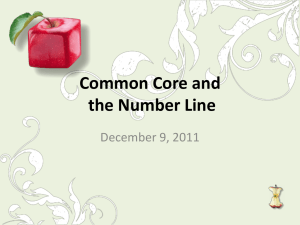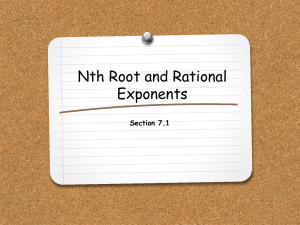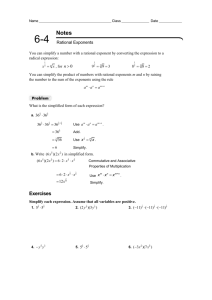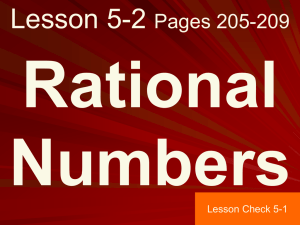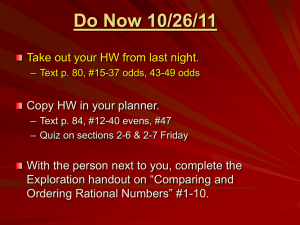Seventh Grade Mathematics Standards Number Sense 1.0 Students
advertisement
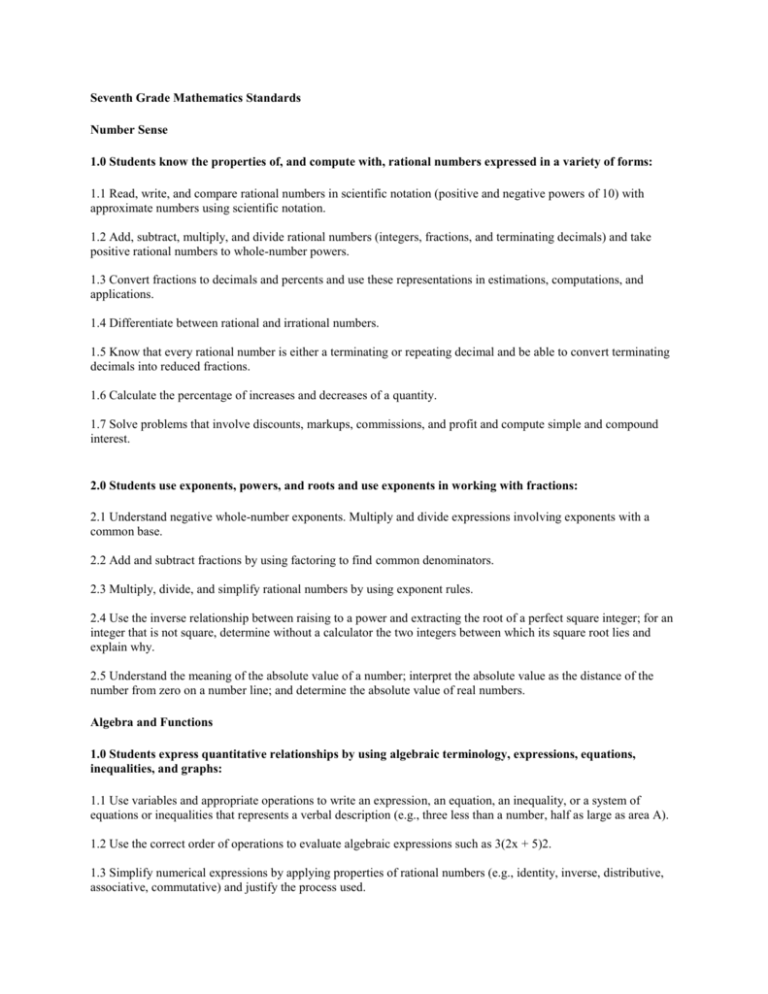
Seventh Grade Mathematics Standards Number Sense 1.0 Students know the properties of, and compute with, rational numbers expressed in a variety of forms: 1.1 Read, write, and compare rational numbers in scientific notation (positive and negative powers of 10) with approximate numbers using scientific notation. 1.2 Add, subtract, multiply, and divide rational numbers (integers, fractions, and terminating decimals) and take positive rational numbers to whole-number powers. 1.3 Convert fractions to decimals and percents and use these representations in estimations, computations, and applications. 1.4 Differentiate between rational and irrational numbers. 1.5 Know that every rational number is either a terminating or repeating decimal and be able to convert terminating decimals into reduced fractions. 1.6 Calculate the percentage of increases and decreases of a quantity. 1.7 Solve problems that involve discounts, markups, commissions, and profit and compute simple and compound interest. 2.0 Students use exponents, powers, and roots and use exponents in working with fractions: 2.1 Understand negative whole-number exponents. Multiply and divide expressions involving exponents with a common base. 2.2 Add and subtract fractions by using factoring to find common denominators. 2.3 Multiply, divide, and simplify rational numbers by using exponent rules. 2.4 Use the inverse relationship between raising to a power and extracting the root of a perfect square integer; for an integer that is not square, determine without a calculator the two integers between which its square root lies and explain why. 2.5 Understand the meaning of the absolute value of a number; interpret the absolute value as the distance of the number from zero on a number line; and determine the absolute value of real numbers. Algebra and Functions 1.0 Students express quantitative relationships by using algebraic terminology, expressions, equations, inequalities, and graphs: 1.1 Use variables and appropriate operations to write an expression, an equation, an inequality, or a system of equations or inequalities that represents a verbal description (e.g., three less than a number, half as large as area A). 1.2 Use the correct order of operations to evaluate algebraic expressions such as 3(2x + 5)2. 1.3 Simplify numerical expressions by applying properties of rational numbers (e.g., identity, inverse, distributive, associative, commutative) and justify the process used. 1.4 Use algebraic terminology (e.g., variable, equation, term, coefficient, inequality, expression, constant) correctly. 1.5 Represent quantitative relationships graphically and interpret the meaning of a specific part of a graph in the situation represented by the graph. 2.0 Students interpret and evaluate expressions involving integer powers and simple roots: 2.1 Interpret positive whole-number powers as repeated multiplication and negative whole-number powers as repeated division or multiplication by the multiplicative inverse. Simplify and evaluate expressions that include exponents. 2.2 Multiply and divide monomials; extend the process of taking powers and extracting roots to monomials when the latter results in a monomial with an integer exponent. 3.0 Students graph and interpret linear and some nonlinear functions: 3.1 Graph functions of the form y = nx2 and y = nx3 and use in solving problems. 3.2 Plot the values from the volumes of three-dimensional shapes for various values of the edge lengths (e.g., cubes with varying edge lengths or a triangle prism with a fixed height and an equilateral triangle base of varying lengths). 3.3 Graph linear functions, noting that the vertical change (change in y- value) per unit of horizontal change (change in x- value) is always the same and know that the ratio ("rise over run") is called the slope of a graph. 3.4 Plot the values of quantities whose ratios are always the same (e.g., cost to the number of an item, feet to inches, circumference to diameter of a circle). Fit a line to the plot and understand that the slope of the line equals the quantities. 4.0 Students solve simple linear equations and inequalities over the rational numbers: 4.1 Solve two-step linear equations and inequalities in one variable over the rational numbers, interpret the solution or solutions in the context from which they arose, and verify the reasonableness of the results. 4.2 Solve multi step problems involving rate, average speed, distance, and time or a direct variation. Measurement and Geometry 1.0 Students choose appropriate units of measure and use ratios to convert within and between measurement systems to solve problems: 1.1 Compare weights, capacities, geometric measures, times, and temperatures within and between measurement systems (e.g., miles per hour and feet per second, cubic inches to cubic centimeters). 1.2 Construct and read drawings and models made to scale. 1.3 Use measures expressed as rates (e.g., speed, density) and measures expressed as products (e.g., person-days) to solve problems; check the units of the solutions; and use dimensional analysis to check the reasonableness of the answer. 2.0 Students compute the perimeter, area, and volume of common geometric objects and use the results to find measures of less common objects. They know how perimeter, area, and volume are affected by changes of scale: 2.1 Use formulas routinely for finding the perimeter and area of basic two-dimensional figures and the surface area and volume of basic three-dimensional figures, including rectangles, parallelograms, trapezoids, squares, triangles, circles, prisms, and cylinders. 2.2 Estimate and compute the area of more complex or irregular two-and three-dimensional figures by breaking the figures down into more basic geometric objects. 2.3 Compute the length of the perimeter, the surface area of the faces, and the volume of a three-dimensional object built from rectangular solids. Understand that when the lengths of all dimensions are multiplied by a scale factor, the surface area is multiplied by the square of the scale factor and the volume is multiplied by the cube of the scale factor. 2.4 Relate the changes in measurement with a change of scale to the units used (e.g., square inches, cubic feet) and to conversions between units (1 square foot = 144 square inches or [1 ft2] = [144 in2], 1 cubic inch is approximately 16.38 cubic centimeters or [1 in3] = [16.38 cm3]). 3.0 Students know the Pythagorean theorem and deepen their understanding of plane and solid geometric shapes by constructing figures that meet given conditions and by identifying attributes of figures: 3.1 Identify and construct basic elements of geometric figures (e.g., altitudes, mid-points, diagonals, angle bisectors, and perpendicular bisectors; central angles, radii, diameters, and chords of circles) by using a compass and straightedge. 3.2 Understand and use coordinate graphs to plot simple figures, determine lengths and areas related to them, and determine their image under translations and reflections. 3.3 Know and understand the Pythagorean theorem and its converse and use it to find the length of the missing side of a right triangle and the lengths of other line segments and, in some situations, empirically verify the Pythagorean theorem by direct measurement. 3.4 Demonstrate an understanding of conditions that indicate two geometrical figures are congruent and what congruence means about the relationships between the sides and angles of the two figures. 3.5 Construct two-dimensional patterns for three-dimensional models, such as cylinders, prisms, and cones. 3.6 Identify elements of three-dimensional geometric objects (e.g., diagonals of rectangular solids) and describe how two or more objects are related in space (e.g., skew lines, the possible ways three planes might intersect). Statistics, Data Analysis, and Probability 1.0 Students collect, organize, and represent data sets that have one or more variables and identify relationships among variables within a data set by hand and through the use of an electronic spreadsheet software program: 1.1 Know various forms of display for data sets, including a stem-and-leaf plot or box-and-whisker plot; use the forms to display a single set of data or to compare two sets of data. 1.2 Represent two numerical variables on a scatter plot and informally describe how the data points are distributed and any apparent relationship that exists between the two variables (e.g., between time spent on homework and grade level). 1.3 Understand the meaning of, and be able to compute, the minimum, the lower quartile, the median, the upper quartile, and the maximum of a data set. Mathematical Reasoning 1.0 Students make decisions about how to approach problems: 1.1 Analyze problems by identifying relationships, distinguishing relevant from irrelevant information, identifying missing information, sequencing and prioritizing information, and observing patterns. 1.2 Formulate and justify mathematical conjectures based on a general description of the mathematical question or problem posed. 1.3 Determine when and how to break a problem into simpler parts. 2.0 Students use strategies, skills, and concepts in finding solutions: 2.1 Use estimation to verify the reasonableness of calculated results. 2.2 Apply strategies and results from simpler problems to more complex problems. 2.3 Estimate unknown quantities graphically and solve for them by using logical reasoning and arithmetic and algebraic techniques. 2.4 Make and test conjectures by using both inductive and deductive reasoning. 2.5 Use a variety of methods, such as words, numbers, symbols, charts, graphs, tables, diagrams, and models, to explain mathematical reasoning. 2.6 Express the solution clearly and logically by using the appropriate mathematical notation and terms and clear language; support solutions with evidence in both verbal and symbolic work. 2.7 Indicate the relative advantages of exact and approximate solutions to problems and give answers to a specified degree of accuracy. 2.8 Make precise calculations and check the validity of the results from the context of the problem. 3.0 Students determine a solution is complete and move beyond a particular problem by generalizing to other situations: 3.1 Evaluate the reasonableness of the solution in the context of the original situation. 3.2 Note the method of deriving the solution and demonstrate a conceptual understanding of the derivation by solving similar problems. 3.3 Develop generalizations of the results obtained and the strategies used and apply them to new problem situations.
